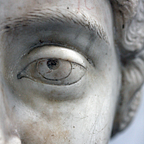A Reversed Perspective: Looking at Greek and Roman Art from Behind(s)
A few weeks ago, I began to ponder the ways in which Greek and Roman art is presented within the modern museum context–and to ruminate on whether we put a bit too much emphasis on the perceived front of a piece of art rather than the side or back of it.
This led to a hashtag that refers specifically to numismatic terminology. In the study of coins, there is the obverse of a coin (i.e. “heads”) and the reverse (i.e. “tails”), and numismatists tend to consider and to value both sides. Here are some of my favorite contributions, along with a few lessons, but you can see them all collected under the #reversenotobverse hashtag on Twitter.
- Ancient hairstyles are better from the back: One of the best ways to look at the hairstyles on Roman women in particular is by going to the back of a bust. Kudos to these beautiful ladies and the artisans that gave them these elaborate coiffures.
2. Ancient buttocks were best appreciated from, well, behind: A number of participants noted the beauty of the classical backside. For the record, I remain a fan of the buttocks on the Riace Bronzes (460–450 BCE) now in the Museum in Reggio-Calabria.
In Ulysses’ Laestrygonians episode (Book 8), Bloom wonders whether sculptures of Greek goddesses in the National Museum in Dublin have anuses, as mortals do. This compels him to do some rather creepy wandering to the backside of these statues in a visit to the museum. When Buck Mulligan engages with Bloom about his leering, he mentions the famed “Venus Kallipyge,” (otherwise known as the Ἀφροδίτη Καλλίπυγος, which translates to ‘Aphrodite of the Beautiful Buttocks’). Today this sculpture resides in the National Archaeological Museum in Naples (MANN).
While I don’t support the sexualized ogling of art that Bloom is criticized for, we can at least appreciate the sculpted beauty of ancient buttocks as glimpsed at in these ancient exempla:
3. Strutting their Stuff: Sometimes the best way to view a sculpture’s strut (the supports) is from the back. Due in part to the fact that Roman sculpture did not have the same integrity as bronze, Roman copies of Greek originals often had tree trunks or other objects that the statue appears to lean on and which help suppport it. In the past few years, the stigma surrounding Roman struts has been diminished and their value underscored. Take a gander at these examples and then buy Anna Anguissola‘s new book, Supports in Roman Marble Sculpture: Workshop Practice and Modes of Viewing.
4. Reconstructions: Sometimes, you get a glimpse into how a piece of art was reconstructed by museum conservators after the fact.
5. Hidden Writing: I am an epigrapher by trade, and thus I was excited to see that a number of people pointed out the hidden writing that could be discovered when we crept around the side or the back of a piece.
6. Breaking the mold: Looking at a piece from behind can give you some idea of how an artisan’s piece was made, particularly ceramics made from molds. At the same time, you may also get some insight into the museum’s previous and current cataloguing habits.
7. Polychromy: Sometimes you can even find some hidden color when you change perspectives.
Do I think that walking around the back of a piece of art is revolutionary? No. I don’t. But I do think that changes to traditional museum perspectives could be more emphasized and can be encouraged through the reworking of exhibits that guide viewers to see sculpture truly in the round. It is one of the great benefits of 3D modeling that we can now engage with more objects in 360 degrees online, rather than only viewing them from flat photographs usually taken only from the front.
I was exceedingly excited to see everyone pitch in and contribute to this hashtag and hope that in your own forays to museums or archaeological sites this summer, you too take a moment to reverse your perspective — and get behind this movement.*
*Revisions of this post removed between 11 and 14 amusing puns about buttocks, but this one stays, okay?
Originally published at sarahemilybond.com on June 24, 2018.
